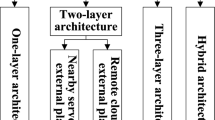Abstract
In the past decade, mobile Internet applications provided by cellular operators have been shifted from an emphasis on one-way content delivery to attention to two-way multimedia interaction. IP-based multimedia application development is booming in the recent years. Without systematical integration among these business support systems, subscribers may receive several different bills from different service providers periodically so as to makes them bedazzled. Meanwhile, cloud computing typically involves provisioning of dynamically scalable resources to provide a powerful computation. Motivated by the aforementioned facts, we propose an Internet Protocol Detail Record based architecture, which can combine different service bills and utilize cloud computing to calculate collectively aggregated bill, to establish a Billing as a Service for cellular operators. In order to validate the efficiency of clouding computing for the aggregated billing calculation, we also conduct performance evaluations for the billing computation over the traditional relational database and our proposed system.











Similar content being viewed by others
References
Leu, J.-S., & Chen, S.-F. (2011). TRASS: A transmission rate-adapted streaming server in a wireless environment. International Journal of Communication Systems, 24, 852–871.
Leu, J.-S. (2008). A lightweight brokering system for content/service charging in a cellular network centric business model. Computer Communications, 31(10), 2078–2085.
Gupta, B. M., & Sarkar, M. Business integration architecture for next generation OSS (NGOSS). http://www.infosys.com/industries/communication-services/white-papers/documents/business-integration.pdf.
Rimal, B. P., & Choi, E. (2012). A service-oriented taxonomical spectrum, cloudy challenges and opportunities of cloud computing. International Journal of Communication Systems, 25, 796–819.
Hsu, I.-C. (2011). Multilayer context cloud framework for mobile Web 2.0: A proposed infrastructure. International Journal of Communication Systems, 26, 610–625.
Tseng, Y.-M., Yang, C.-C., & Su, J.-H. (2004). Authentication and billing protocols for the integration of WLAN and 3G networks. Wireless Personal Communications, 29(3–4), 351–366.
Jeffrey, D., & Sanjay, G. (2008). MapReduce: Simplified data processing on large clusters. Communications of the ACM, 51, 107–113.
Johnson, J. L. (2009). SQL in the clouds. Computing in Science & Engineering, 11, 12–28.
Wei, J., Ravi, V. T., & Agrawal, G. (2009). Comparing map-reduce and FREERIDE for data-intensive applications. In IEEE International conference on cluster computing and workshops, 2009. CLUSTER ‘09 (pp. 1–10).
Mackey, G., Sehrish, S., Bent, J., Lopez, J., Habib, S., & Wang, J. (2008). Introducing map-reduce to high end computing. In 3rd petascale data storage workshop, 2008. PDSW ‘08 (pp. 1–6).
Xia, T. (2008). Large-scale SMS messages mining based on map-reduce. In International symposium on computational intelligence and design, 2008. ISCID ‘08 (pp. 7–12).
Pan, J., Magoulès, F., Biannic, Y. L., & Favart, C. (2013). Parallelizing multiple group-by queries using MapReduce: Optimization and cost estimation. Telecommunication Systems, 52(2), 635–645.
ipdr.org. Network data management—Usage(NDM-U) for IP-based services, version 3.1.1, October, 2002.
Parallel MapReduce in Python in ten minutes. http://mikecvet.wordpress.com/2010/07/02/parallel-mapreduce-in-python/.
HDFS architecture guide. http://hadoop.apache.org/docs/r1.0.4/hdfs_design.html.
The NIST definition of cloud computing. NIST definition ver. 15, October 7, 2009.
Simple Object Access Protocol (SOAP), W3C SOAP 1.1, May 8, 2000.
Ryan C., Rousseau, B., O’Riordan, C., & Vejgaard-Nielsen, S. Flexible billing for a personalised mobile services environment. http://www.tssg.org. Accessed on February 21, 2005.
Leu, J.-S., Yee, Y.-S., & Chen, W.-L. (2013). Comparison of Map-Reduce and SQL on large-scale data processing. Journal of the Chinese Institute of Engineers, 36(1), 27–34.
Author information
Authors and Affiliations
Corresponding author
Rights and permissions
About this article
Cite this article
Leu, JS., Hsieh, WB. & Yee, YS. Implementing Billing as a Service by an IPDR Aggregator System. Wireless Pers Commun 87, 1223–1240 (2016). https://doi.org/10.1007/s11277-015-3050-6
Published:
Issue Date:
DOI: https://doi.org/10.1007/s11277-015-3050-6




